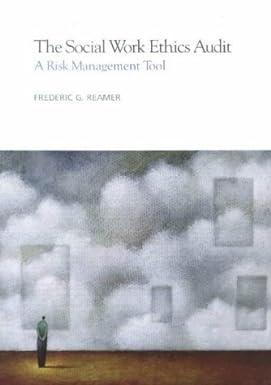Question
Entity A sold Product C to Entity B for many years. In order to expand its market, recently, Entity A promoted a new product, i.e.
Entity A sold Product C to Entity B for many years. In order to expand its market, recently, Entity A promoted a new product, i.e. Product D. On 1 January 2020, Entity A sold 20,000 units of Product D to Entity B at a price of $88 per unit. Cash was received when control of products transferred to Entity B.
According to the contract between Entity A and Entity B, Entity A agreed with Entity B returning unused products at full price within 2 months, i.e. on or before 29 February 2020. The costs of each Product C and Product D are $55 and $48 respectively.
Entity A learnt much experience in selling Product C with different customers and estimated that 6% of Product C was commonly returned by Entity B. However, Product D is a new product, therefore Entity A did not have such experience on selling Product D. Based on the good business relationship with Entity B, Entity A estimated the return rate of Product D as a triple of the return rate of Product C.
On 29 February 2020, Entity B returned 1,600 units of Product D to Entity A. Due to a cash shortage, Entity A only repaid $50,000 back to Entity B and promised to settle the unpaid balance on or before 31 March 2020. Finally, Entity A only settled 80% of the unpaid balance on 31 March 2020.
REQUIRED:
Provide journal entries for Product D from 1 January 2020 to 31 March 2020 in accordance with relevant accounting standards.
ACCOUNT NAMES FOR INPUT:
| Road roller | Plant | Machine | Motor van | Land | Building | Inventory | Intangible assets |
| Bank | Payable | Receivable | Other income | Other expense | Interest expense | Interest revenue |
| Depreciation | Accum. depreciation | Impairment loss | Reversal of impairment loss | Goodwill |
| Loss on disposal | Gain on disposal | Restoration liability | Revaluation surplus | Revaluation deficit |
| Asset for product to be returned | Commission expense | Commission revenue | Revenue |
| Cost of sales | Refund liability | Contract asset | Contract liability | Retained earnings | No entry |
ANSWERS:
Journal Entries:
| Date | Account Name | Debit ($) | Credit ($) | |
| 1-Jan-20 | Blank 1 | Blank 2 | ||
| Blank 3 | Blank 4 | |||
| Blank 5 | Blank 6 | |||
| Blank 7 | Blank 8 | |||
| Blank 9 | Blank 10 | |||
| Blank 11 | Blank 12 | |||
| Blank 13 | Blank 14 | |||
| Blank 15 | Blank 16 | |||
| 29-Feb-20 | Blank 17 | Blank 18 | ||
| Blank 19 | Blank 20 | |||
| Blank 21 | Blank 22 | |||
| Blank 23 | Blank 24 | |||
| Blank 25 | Blank 26 | |||
| 29-Feb-20 | Blank 27 | Blank 28 | ||
| Blank 29 | Blank 30 | |||
| Blank 31 | Blank 32 | |||
| Blank 33 | Blank 34 | |||
| Blank 35 | Blank 36 | |||
| 31-Mar-20 | Blank 37 | Blank 38 | ||
| Blank 39 | Blank 40 | |||
| Blank 41 | Blank 42 | |||
| Blank 43 | Blank 44 | |||
Step by Step Solution
There are 3 Steps involved in it
Step: 1

Get Instant Access to Expert-Tailored Solutions
See step-by-step solutions with expert insights and AI powered tools for academic success
Step: 2

Step: 3

Ace Your Homework with AI
Get the answers you need in no time with our AI-driven, step-by-step assistance
Get Started


